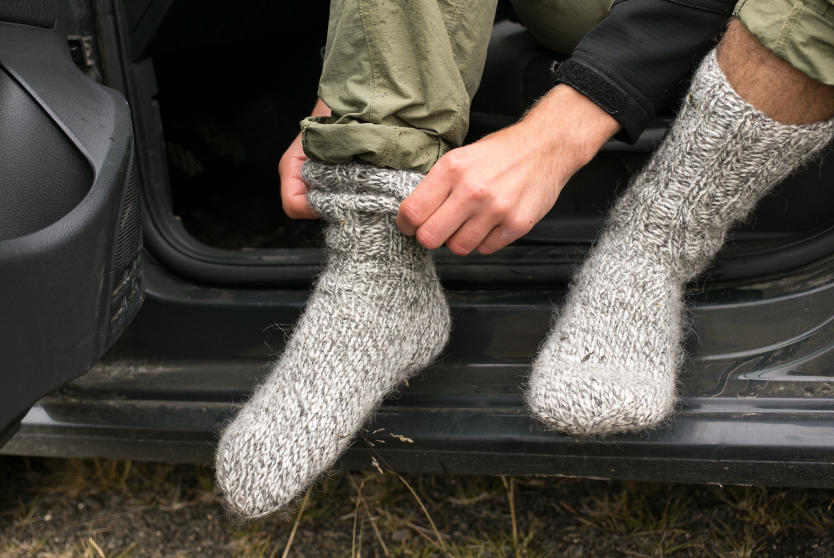What are the best socks for hiking?
Hiking boots are one of the most important pieces of kit to get right so that you can have a great time walking on the moors, up hills, through the countryside, or along the coast. For this reason, it is very easy to forget that you’ll also need to bring a pair of socks that match their quality.
Get it wrong, and you could find yourself out on a trail wanting to go home. So choosing the right pair of walking socks to go with your boots is essential to the whole experience.
Why can’t you just use your everyday socks?
Your feet sweat much more when you’re out hiking, and they are also much more prone to chafing or blistering; something your regular socks are not designed to prevent.
It could even be your hiking boots that your socks need to protect you against. Even if you own a high-end pair of boots, they could be tough and tight and very hard to walk in for a long time without the proper socks on your feet.
Choosing the right sock fabric
Hiking socks are usually made from a blend of fabrics rather than one single type, and this is because the blend helps to create a balance of warmth, comfort, fast-drying, and durability – things that you cannot accomplish from a single fabric product.
Below we are going to discuss some of the fabrics you should be looking out for when choosing a pair of hiking socks that are right for you and your feet.
Wool
By far the most popular type of hiking material is wool, and it is a fabric that long time hikers would recommend above all of the others available.
As you may know from the wooly jumpers you wear in the wintertime, wool helps to regulate temperature well to keep things warm and cozy whilst not causing you to sweat. Wool socks can provide exactly this and they also provide a decent amount of cushioning for your feet too.
Wool hiking socks also tend to be made from merino wool, which is essentially an itch-free material. This is therefore much better when compared to the older types of rag wool socks once commonly worn.
Polyester
Polyester is a synthetic material that insulates, wicks away moisture and dries quickly.
Often blended with wool and/or nylon, they help to create a good combination of warmth and comfort – along with handy durability and fast-drying to help increase further feelings of comfort whilst out on hiking trail.
Silk
A natural insulator, silk is a comfortable and lightweight fabric though it lacks in the department of durability due to the way it is made. It is, for this reason, that silk is an unlikely choice for long-distance hikers.
Though with that being said, it is still occasionally used in sock liners for the purpose of moisture-wicking.
Nylon
Although not as common as wool, nylon is sometimes used as a primary material in hiking socks as it provides durability and can help improve drying times when used.
Spandex
Many hiking socks will use a small percent of spandex in their material combination as a way of making sure the socks can hold their shape. This helps to prevent them from bunching and wrinkling too much.
Make sure they fit on your feet
Whatever combination of materials you end up going with, based on what sort of hiker you are, it is important that they fit comfortably on your feet. As mentioned at the beginning of this article this is essential if you’re looking to find enjoyment from your hikes – which is really a no-brainer.
If your socks are too big and baggy on your feet, they will wrinkle easily and may rub against your feet which can cause blisters.
Too small and they can create pressure points that could irritate your feet, not to mention they’ll generally be uncomfortable and this will be much more apparent after spending hours outside on your favorite trail.
Finding the right size
You’re going to want to make sure you pick socks that match the size of your feet rather than going with the size of your shoe, otherwise, you’ll be choosing socks that are just too large for you and you will suffer the drawbacks as mentioned above.
Your want your socks to be snug on your feet, not overly tight. One telltale sign that your socks fit on your feet properly is when the heel cup actually lines up with the heel of your foot.
Summary
Hiking socks are as important to you and as hiking shoes are, for this reason, it is essential to find a pair that are right for your feet. The most important factors to consider when buying a pair of hiking socks are that they contain the right materials that are the best for whatever you’re getting up to and that they fit your feet properly.
If it means spending a little extra on high a high-quality pair, then so be it. Your feet will be thanking you during your long adventures.

